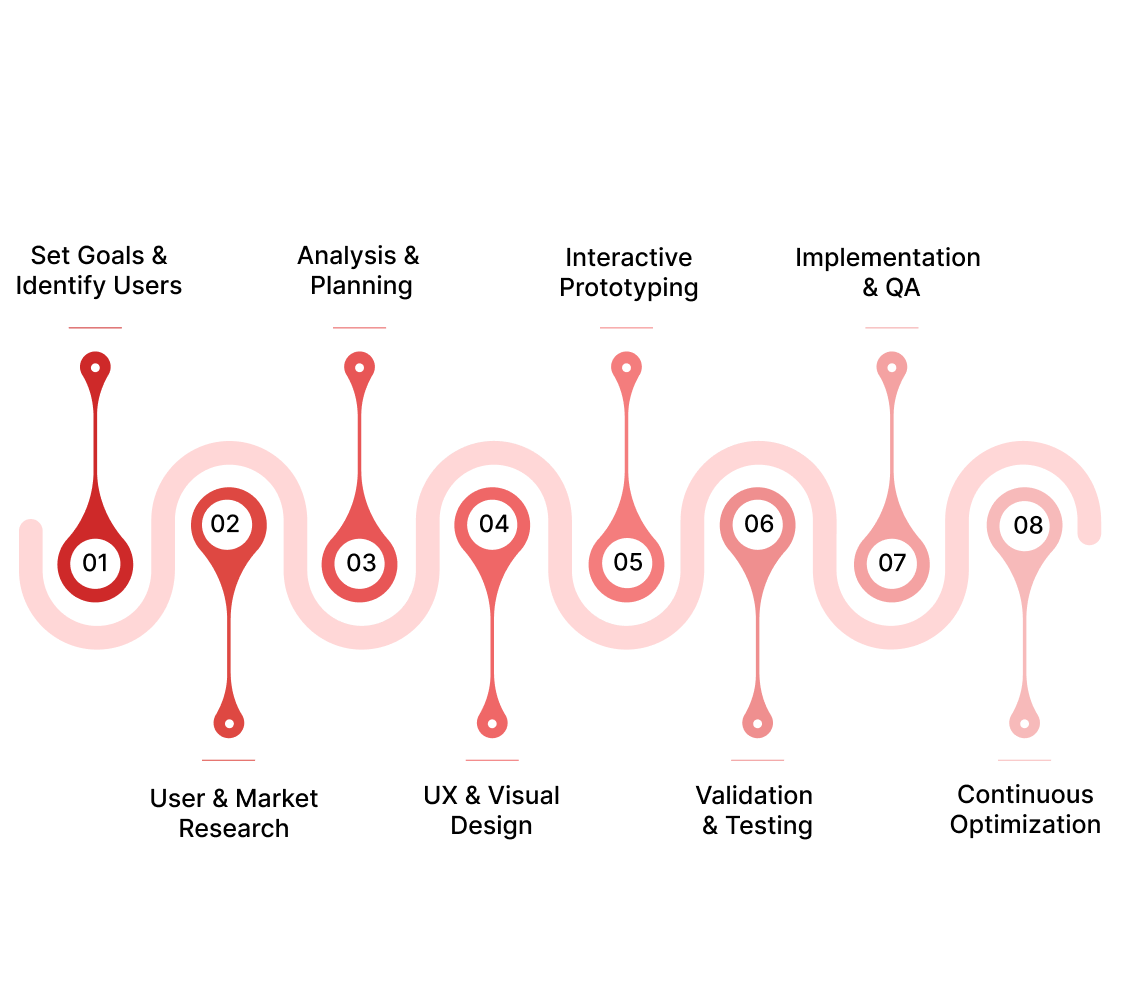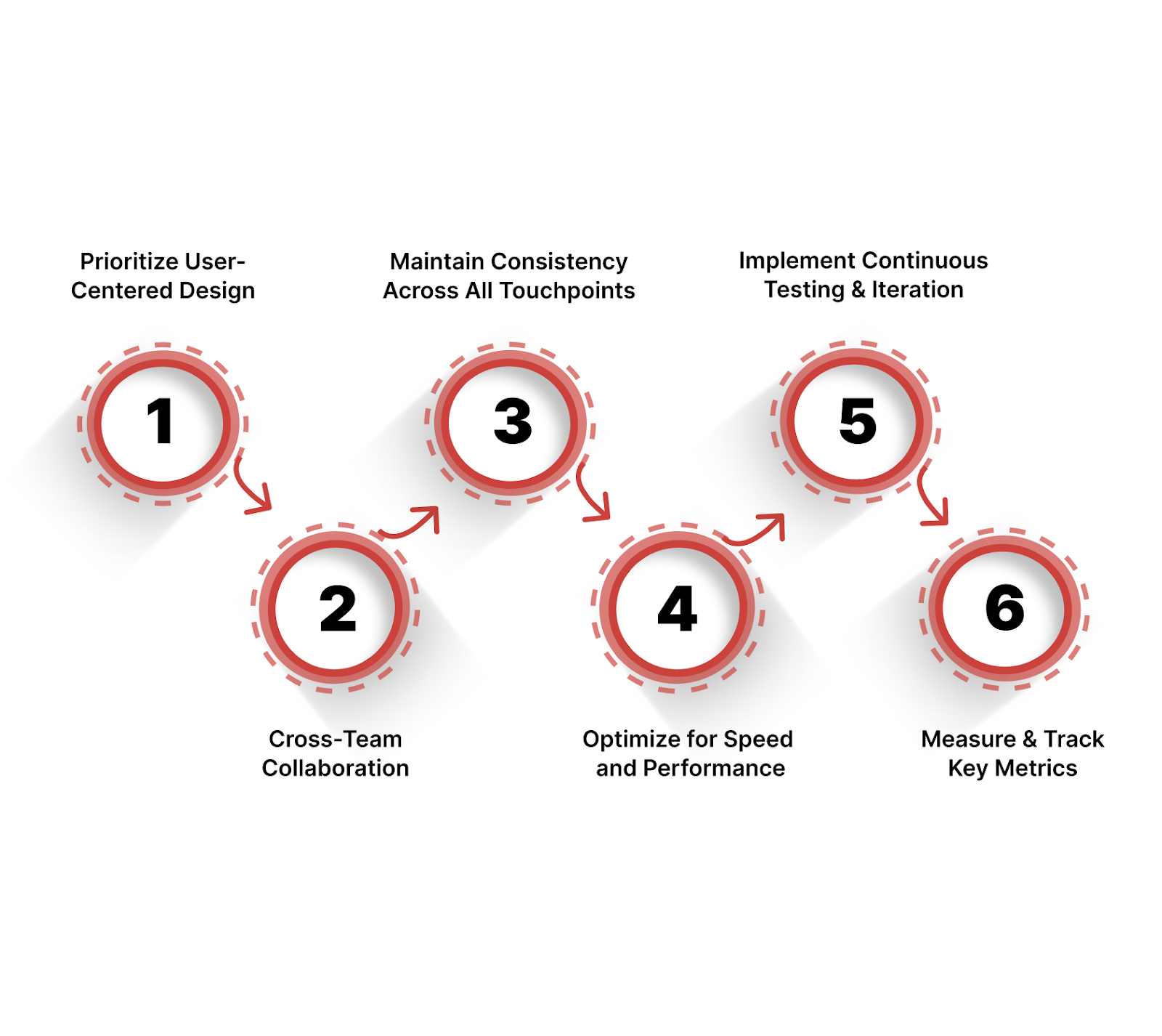Your SaaS website is not just an online brochure; it's the core of your business growth. But here's the reality: the average conversion rate for landing pages across all industries is only 3.8%, well below the all-industry benchmark of 6.6%.
We understand how frustrating it can be to put in the work, only to see visitors bounce before they take action. This presents a massive opportunity for improvement. By following a structured process of UX, you can turn that low conversion rate into a high-growth engine for your business.
In fact, 67% of B2B buyers abandon software evaluations due to poor UX. This highlights the importance of optimizing your website's UX to convert more visitors into customers.
In this blog, you'll discover the 8-step UX process that successful SaaS teams use to increase conversions and turn their websites into effective sales tools.
Key Takeaways
- Structured UX Process: A formal UX process aligns teams, improves decision-making, and increases conversions.
- Data-Driven Design: Research and testing identify user pain points and optimize website flows.
- Team Collaboration: Design, product, marketing, and development must work together for a seamless UX.
- Continuous Iteration: Regular testing and feedback are essential for ongoing UX improvements.
- Measure Metrics: Track conversion rates and user satisfaction to refine your UX strategy.
Why Following a Formal UX Process is Crucial for Your Website?
You may ask: “Do I really need a process of user experience (UX) when we already have traffic and users?” The short answer is yes. Without a structured approach, you’ll patch symptoms, not root problems. Inconsistent messaging, friction in critical flows, and design changes that fail to move meaningful metrics are common pitfalls.
A proper UX process aligns your team, including design, product, and marketing, around hypotheses. It ensures decisions are evidence-based and provides guardrails so you don’t ship blind. In short, it turns UX from guesswork into a strategic advantage.
By following a formal UX process, you can benefit in the following ways:
- Improved User Experience: Identify pain points early and refine the design to make the user journey smoother and more intuitive.
- Increased Conversions: Optimize critical flows to remove friction and drive more conversions.
- Consistent Messaging: Ensure alignment across teams and deliver consistent messaging that resonates with users.
- Data-Driven Decisions: Make informed decisions based on research, testing, and user feedback, rather than assumptions.
- Scalability: Develop a repeatable process that scales with your growing product and user base.
Now that you understand why a structured approach matters, it’s time to put theory into action. Let’s walk through the UX process for building a SaaS website that drives conversions. These steps provide a repeatable, step-by-step roadmap to turn your SaaS website into a lead-generating, conversion-focused asset.
Process of UX to Improve User Experience: 8 Key Steps Explained

The process of UX is a structured, repeatable approach that connects user needs to measurable business outcomes. Each step below is designed to help your team systematically improve your website, reduce friction in critical flows, and ultimately increase conversions and long-term retention.
Step 1: Set Goals & Identify Users
Starting with clarity ensures your team works on the right problems from day one, saving time and resources while maximizing impact.
What You Do:
- Set Objectives: Identify specific goals, such as increasing trial signups, demo requests, or paid plan conversions, and make them measurable.
- Identify Personas: Create detailed user personas that go beyond demographics, including pain points, motivations, and usage patterns.
- Establish KPIs: Define conversion and engagement metrics that matter most to your business, ensuring everyone can track success.
- Align Stakeholders: Bring together design, product, marketing, and leadership teams so all decisions are guided by the same vision and objectives.
Deliverables:
- Project brief outlining goals, success metrics, and scope.
- Persona profiles that include behaviors, frustrations, and triggers.
- Baseline performance data to track UX improvements over time.
Why It Matters: Without a precise definition, teams end up solving the wrong problems. A well-defined start ensures every design decision drives measurable business value and creates a foundation for scalable UX improvements.
Step 2: User & Market Research
Gather insights that reveal how your users behave, what frustrates them, and how your SaaS compares to competitors.
What You Do:
- Qualitative Research: Conduct user interviews, focus groups, or surveys to uncover pain points and desired outcomes.
- Quantitative Analysis: Examine analytics, heatmaps, and session recordings to identify drop-offs, friction points, and high-value interactions.
- Competitive Benchmarking: Analyze competitors and best-in-class SaaS experiences to identify opportunities and set design standards.
- Internal Insights: Gather feedback from sales, customer success, and support teams to capture real-world problems and objections.
Deliverables:
- Comprehensive research report summarizing user pain points, behaviors, and opportunities.
- Visual user journey maps highlighting critical touchpoints and bottlenecks.
- Competitive UX benchmarking to inform design decisions.
Why It Matters: Evidence-based research ensures your UX decisions address real user needs, reducing guesswork, boosting conversions, and strengthening long-term engagement. It helps you prioritize solutions that truly impact revenue.
Step 3: Analysis & Planning
Analysis turns research into strategy, giving your team a clear roadmap and prioritization plan to deliver maximum impact.
What You Do:
- Identify Bottlenecks: Pinpoint the exact moments in your website or product where users drop off or struggle.
- Prioritize Features: Utilize effort-impact matrices to concentrate on changes that yield the greatest return on UX investment.
- Map User Journeys: Visualize touchpoints across marketing, product, and support to understand the full experience.
- Formulate Hypotheses: Define assumptions and create testable hypotheses to validate in the next design and testing stages.
Deliverables:
- Prioritized UX roadmap detailing features, flows, and experiments.
- End-to-end user journey maps with identified friction points.
- Hypothesis documentation for validating design solutions.
Why It Matters: A structured plan ensures your UX team prioritizes the highest-impact changes. Without it, teams often focus on cosmetic fixes that don’t improve key SaaS metrics like activation, retention, or revenue.
Step 4: UX & Visual Design
Design transforms strategy into intuitive, conversion-focused experiences that guide users naturally toward desired actions.
What You Do:
- Wireframes: Start with low-fidelity layouts for essential pages like homepage, pricing, onboarding, and dashboards.
- High-Fidelity Mockups: Create polished screens with consistent visual hierarchy, typography, and brand alignment.
- Interaction Design: Define button states, micro-animations, error states, and microcopy to ensure clarity and engagement.
- Design System: Standardize components, colors, and interactions to maintain consistency across all user touchpoints.
Deliverables:
- Wireframes and high-fidelity mockups for critical flows.
- Design system or component library for consistency.
- Annotated specifications for seamless developer handoff.
Why It Matters: Great SaaS UX design reduces friction, clarifies the path to conversion, and builds trust with B2B buyers. A consistent, thoughtful interface is key to turning trial users into paying customers.
Step 5: Interactive Prototyping
Prototyping allows you to test flows interactively, identify issues early, and iterate without costly development mistakes.
What You Do:
- Build Interactive Prototypes: Include all critical SaaS flows, such as signup, onboarding, pricing selection, and dashboard navigation.
- Stakeholder Review: Share with internal teams to ensure alignment before user testing.
- User Validation: Conduct a test with a small group of target users to identify usability issues and gaps in understanding.
Deliverables:
- Clickable prototypes covering primary user flows.
- Feedback logs highlighting friction points and opportunities for improvement.
Why It Matters: Prototyping allows your team to identify and resolve problems before they reach development, saving time, reducing errors, and improving adoption rates.
Step 6: Validation & Testing
Testing ensures that your design decisions are effective, measurable, and truly solve user problems.
What You Do:
- Usability Testing: Observe users completing real tasks to identify friction and confusion.
- A/B Testing: Test variations on headlines, CTAs, forms, and flows to determine what drives higher conversions.
- Behavior Analysis: Track task success rates, errors, engagement, and drop-offs.
- Qualitative Feedback: Collect insights via surveys, session recordings, and heatmaps.
Deliverables:
- Usability testing reports with actionable insights.
- A/B test results with clear recommendations.
- Updated wireframes or prototypes incorporating learnings.
Why It Matters: Testing validates assumptions, minimizes risk, and ensures UX improvements have a tangible impact on SaaS metrics like activation, conversion, and retention.
Step 7: Implementation & QA
A smooth launch ensures the UX work translates into measurable business results.
What You Do:
- Developer Handoff: Provide final assets, specifications, and guidelines to ensure accurate implementation.
- Quality Assurance: Test responsiveness, interactivity, and performance across devices.
- Analytics Setup: Implement tracking to measure funnel performance, feature adoption, and conversion metrics.
Deliverables:
- Production-ready assets and specifications.
- QA reports and bug tracking.
- Conversion and analytics tracking configured.
Why It Matters: A proper launch ensures the intended UX experience is delivered to users, providing reliable data to measure performance and optimize further.
Step 8: Continuous Optimization
UX is never done. Continuous improvement is critical for SaaS growth, retention, and long-term success.
What You Do:
- Monitor Metrics: Regularly analyze engagement, conversions, drop-offs, and feature usage.
- Collect Feedback: Utilize surveys, support tickets, and session recordings to gain real-time insights.
- Experiment & Improve: Test small iterations and run A/B experiments to optimize flows.
- Scheduled UX Audits: Conduct quarterly or semi-annual reviews to refine UX and conversion strategies.
Deliverables:
- Post-launch performance report with actionable insights.
- Iteration backlog with prioritized improvements.
- Updated prototypes or mockups reflecting refinements.
Why It Matters: Continuous iteration keeps your SaaS experience optimized for real user needs, ensures steady improvement in conversion metrics, and maintains a competitive edge in a fast-moving market.
At Beetle Beetle, we specialize in creating high-converting websites for B2B SaaS companies. Our comprehensive approach includes website audits, design, copywriting, and development to optimize user experience and drive conversions. To learn more, visit Beetle Beetle and see how we can help transform your website.
Now, let's explore how each team member plays a crucial role in contributing to a successful UX strategy.
How Each Team Member Contributes to a Successful UX Strategy?

A successful UX strategy depends on collaboration between teams, each bringing their expertise to create a seamless website user experience. When design, product, marketing, development, and research teams align, the result is a website that engages visitors and drives conversions.
Here’s how each team contributes to the UX process:
- Design Team: The design team creates the visual elements and interactive components of the website. They focus on making sure the design is intuitive, user-friendly, and aligns with the brand's identity.
- Product Team: The product team ensures that UX improvements align with the overall product roadmap. They use data and feedback to guide design decisions that support business goals and user needs.
- Marketing Team: The marketing team crafts messaging and content that resonates with the target audience. They ensure that the user experience drives engagement and conversions by optimizing the customer journey.
- Development Team: The development team turns designs into a functional, responsive website. They ensure seamless performance, cross-device compatibility, and technical integration, optimizing for speed and usability.
- UX Researchers: UX researchers gather user insights through interviews, surveys, and testing. They provide data to validate designs, identify pain points, and refine the user experience for better usability.
Now that we’ve outlined how each team contributes to the UX process, let’s explore the best practices that can refine your UX strategy and drive measurable results.
Effective Strategies for Optimizing Your UX Design

To create an effective UX strategy, follow best practices that enhance collaboration, ensure consistency, and improve efficiency. These practices help deliver a smooth and intuitive user experience, ultimately increasing conversions.
Here are the key practices that can elevate your UX strategy:
- Prioritize User-Centered Design: Always start with the user in mind. Collect user feedback, perform usability testing, and iterate based on real data. This ensures your design decisions are based on actual user needs and behaviors.
- Encourage Cross-Team Collaboration: Build a collaborative environment where design, product, marketing, and development teams communicate openly. This ensures alignment on goals, expectations, and timelines, leading to smoother execution and a more cohesive user experience.
- Maintain Consistency Across All Touchpoints: Consistency is key in UX. From messaging to visuals, ensure all elements align with your brand identity and create a unified experience, whether users are interacting with your website, app, or email campaigns.
- Optimize for Speed and Performance: Users expect fast load times and smooth performance. Optimize your website’s speed, reduce friction, and make sure all interactive elements work seamlessly across devices and browsers to minimize drop-offs.
- Implement Continuous Testing and Iteration: UX is not a one-and-done process. Regularly test new features, layouts, and designs with real users. Gather feedback and adjust based on results to continually improve the user experience.
- Measure and Track Key Metrics: Utilize analytics tools to monitor key UX metrics, including conversion rates, bounce rates, and user satisfaction. Data-driven insights will help you refine your strategy and ensure that your UX efforts are aligned with business goals.
By following these best practices, your SaaS team can ensure that your UX strategy is not only efficient but also effective at driving higher conversions and building long-term customer loyalty.
Build a UX Strategy That Delivers Results
A successful UX strategy for your website is about creating a seamless user experience that drives conversions. By following a structured UX design process, you ensure each page is optimized for engagement and lead generation. This approach helps turn visitors into valuable customers while meeting your business goals.
For a focused and conversion-driven website, visit Beetle Beetle. We specialize in designing and developing websites for B2B SaaS companies, ensuring your website is built to attract and convert. Our expertise will help you maximize your site’s performance and support your growth objectives.
Ready to optimize your website’s UX? Schedule a strategy call with Beetle Beetle and start transforming your website into a high-converting platform today.
































